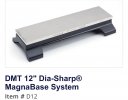I have sets of diamond plates by Atoma, DMT, and Ultra Sharp. I have used them all, and I do not see a great deal of difference from one manufacturer to another. They all do what they are supposed to do, on the hardest, most stubborn steels, and leave a consistent satin finish. They will do things that the best natural stones cannot, and they are less expensive than natural stones.
The Atoma 140 seems to cut better and last longer than the low grit stones from DMT and Ultra, otherwise I would suggest buying 8x3 diamond plates from any of those three manufacturers. Buy whatever is on sale.
One extremely important issue to keep in mind is the break-in is life-or-death important! Failing to completely break in your new diamond plate is a one-way ticket to Chip City!!! All the new stones need it, and they will let you know right away if you fail to take the ten minutes it takes to get the stone ready for use.
Lube with diluted Krud Kutter, strop with diamonds.






